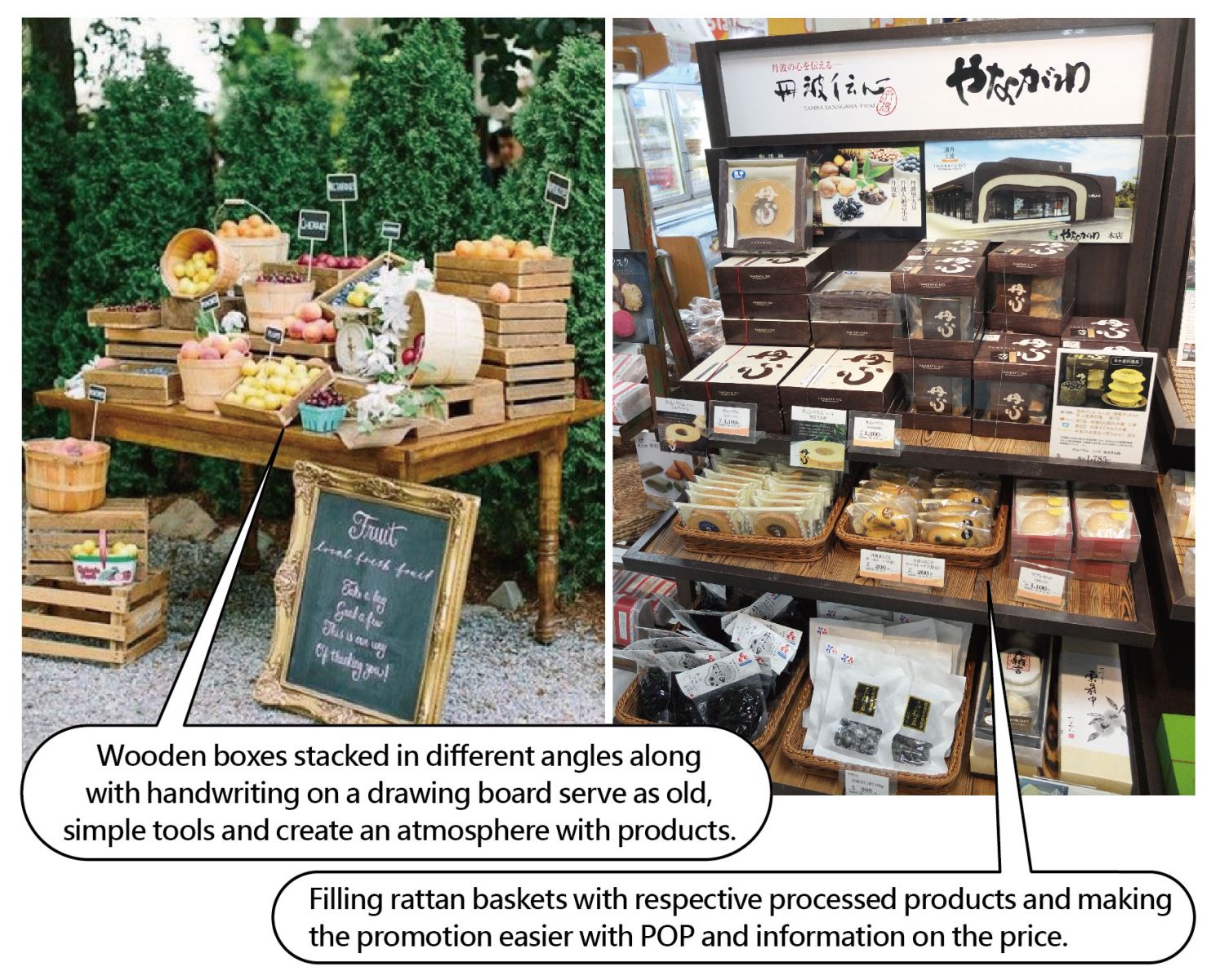Points Of Customer Attraction - Agricultural Product Display In Markets
Neer Chuang (China Productivity Center Smart Agriculture Promotion Department)
I. Preface
The agriculture industry in Taiwan has faced significant internal and external environmental changes in recent years, including the extreme weather around the world and the impact of trade liberalization, which have resulted in the insufficient size of Taiwan’s domestic market, labor shortage and aging in the agriculture industry, and an increase in the consumers’ food safety awareness. In order to raise awareness among the public regarding agricultural and environmental sustainability issues, the Ministry of Agriculture collected opinions from various sectors through diverse channels. The “6th National Agricultural Conference” was also held in 2018 to outline the future direction for the agriculture industry in Taiwan and had discussions on four main themes: “agricultural safety”, “prospects”, “sustainability”, and “happiness”.
In order to improve the quality of agricultural decision-making along with that of the governance, an agricultural product safety system was established to enhance the functions of farmers' organizations and industrial organizations as well as assisting small farmers in dealing with production and marketing in the hope of reducing production costs for small farmers, increasing farmers' income, and stabilizing production mechanisms through the operation and training of agricultural organizations. Further, it is hoped that small farmers can receive effective assistance in addressing production and marketing affairs and that the management, processing, and marketing of agricultural products can be improved, thereby facilitating the diverse utilization of agricultural products.
II. Nature of Market Display: Commercial Purpose/Promotion/Brand/Advertisement
As quality agriculture being actively promoted in Taiwan, the goal has been to prevent the aging of practicing farmers. Thus, the “Top 100 Young Farmers Project” has been launched and a series of actions have been taken to guide young people back to the countryside and provide counseling on farming. Farmers are also guided to carry out long-term, regular promotional and assembly activities for agricultural products in cities, farmer markets, and key public spaces (e.g., the Taipei Hope Plaza Farmer Market and the Yuanshan Park Area of the Taipei Expo Park). With the growing number of agricultural product stores, various market activities themed around festivals also spread across different regions for people to sell agricultural products or participate in exhibitions.
Consumers' habits of purchasing agricultural products have gradually shifted from shopping in traditional markets to buying at organic stores or attending markets to learn about and purchase various high-quality agricultural products. The mode of selling agricultural products by Taiwanese farmers has also gradually changed, that is, from handing the products over to wholesalers to directly participating in regular “market sales”, which is an opportunity to promote the farmers’ own products and a focal point of sales expansion. With active participation in seasonal fruit relevant market activities organized in each county and city, promotion and advertisements, and on-site cooking and tasting, the face-to-face and real-time experiences can deepen the public’s understanding of planting methods and cooking skills of the local vegetables and fruits in Taiwan. It is hoped that people can shift away from the hurried daily fast-food culture and, by experiencing agriculture production, marketing, low-carbon diets, eco-friendliness, local production for local sales, and the agri-food culture through participation in leisurely markets, get close to agricultural products and gradually return to a healthier local dietary culture.
The nature of displaying agricultural products at market stalls includes commercial purpose, sales promotion, brand promotion and advertisement display. The aim is to focus on displaying for “information transmission, sales promotion, and education”, enabling connections between people and products. Therefore, in order to attract the customers’ attention “at first glance” through product displaying, we craft visual aesthetics to convey product features and further enable consumers to communicate with operators and learn about the agricultural products and brand characteristics. This triggers the potential buying desire of the consumers and successfully facilitates purchases.
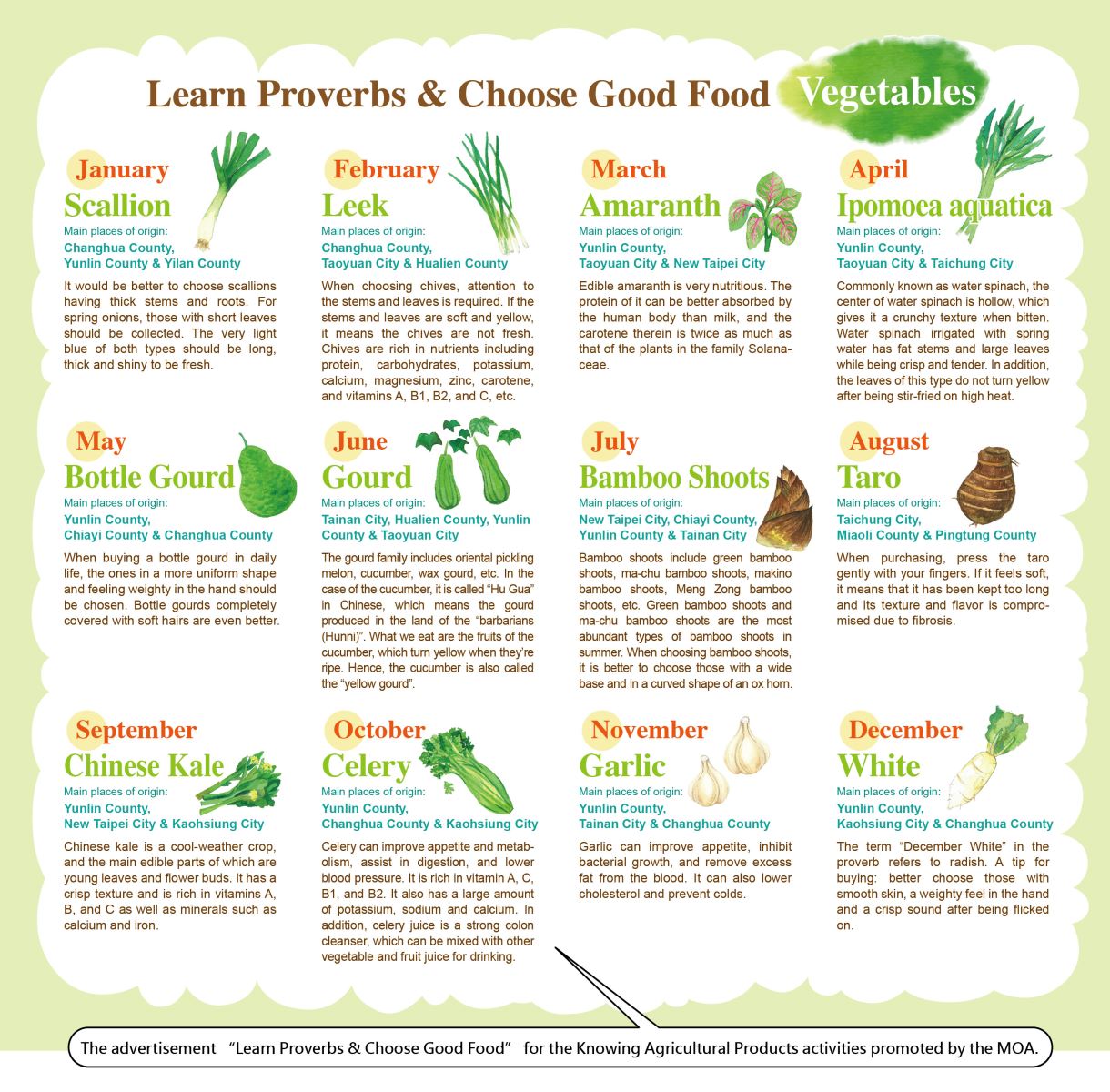
III. Pre-sale / Preparatory Work for Displaying Agricultural Products
- Brand planning
- Displaying the brand (Trademark)
We promote brand logos, fonts, and color configurations that are consistent with product concepts to deliver brand spirit through the commodities. This is also applied to visual design. For example, we pay attention to visual combinations when it comes to signs, business cards, advertisements and promotional materials, price tags, vests and clothing, social media, and other combinations for advertising and promotion in response to the brands’ norms and show their characteristics. The color schemes, fonts, and positions concerning the combinations that are regulated by the brands for operational purposes should be presented consistently, aiming to make consumers recognize and accept the brand meanings, repurchase the products, and become loyal customers of the brands.
The planning of trademark and logo configuration is crucial for showing the price of agricultural products and establishing brands. Displaying the brand logo, drawn with chalk on a chalkboard, in hand-drawn style creates a simple atmosphere. Another option is to place a brochure that introduces the agricultural products with photos thereof. By presenting brand logos or various images of agricultural products in special arrangements in the content, the customers’ attention can be attracted, encouraging the customers to actively interact with the farmers. The consumers appreciate friendly and enthusiastic greetings in the stores. Before the farmers communicate with the consumers verbally, the displays serve as “a silent promotion method to the external world” and a forefront way to showcase individual characteristics.
- Agricultural product sorting and classification (seasonality/type/size/color)
Seasonality: Spring strawberries are the sweetest; summer watermelons are refreshing and clear summer heat.
Type: Vegetables, gourds, mushrooms, and fruits.
Size: Place larger items towards the back and smaller items towards the front. Note that the overall display should not block the promotional materials.
Color: Arrange and display the agricultural products after dividing them into warm, neutral, and cool-colored products.
The influence of color on visual experiences can evoke the most direct and intense emotional responses. The color wheel in the figure below shows neutral, warm, and cool colors, indicating that when people look at colors, they have the following exemplary perceptions through the connection of different experiences: a cool feeling brought by blue; a sense of enthusiasm provided by red; and a sense of health and freshness that belongs to green.

- Stall configuration/I.P (item presentation)
Market sales involve direct transactions, which require the ability to “catch the eye at first glance” and retain the customer attention. Therefore, the display should emphasize and show product features so that the customers can easily choose products. The principles of being easy to see, easy to get, and easy to choose should be adhered to.
- Lighting creation/golden display area
- Poor lighting can make agricultural products seem less fresh, and displaying with dim lights may create the illusion of backward movement. Therefore, it is recommended to use spotlights for localized illumination to enhance the visual freshness of the commodities, achieving an effect that highlights the features and emphasizes the main subject of the commodities, and further enriching the consumers' visual experience.
- The height of the display is also one of the key factors in making it “easy to see”. According to a market survey of department stores in Japan, the height at which products are most easily seen is referred to as the “golden display area” (Fig. 2). The majority of customers buying agricultural products are women, and the average height of women falls between 150cm and 160 cm. The optimal horizontal line of sight for humans is at a height of around 145cm. As people tend to scan items that are positioned below the horizontal line of sight, the area 60cm to 120cm above the ground is the easiest to see for the customers.
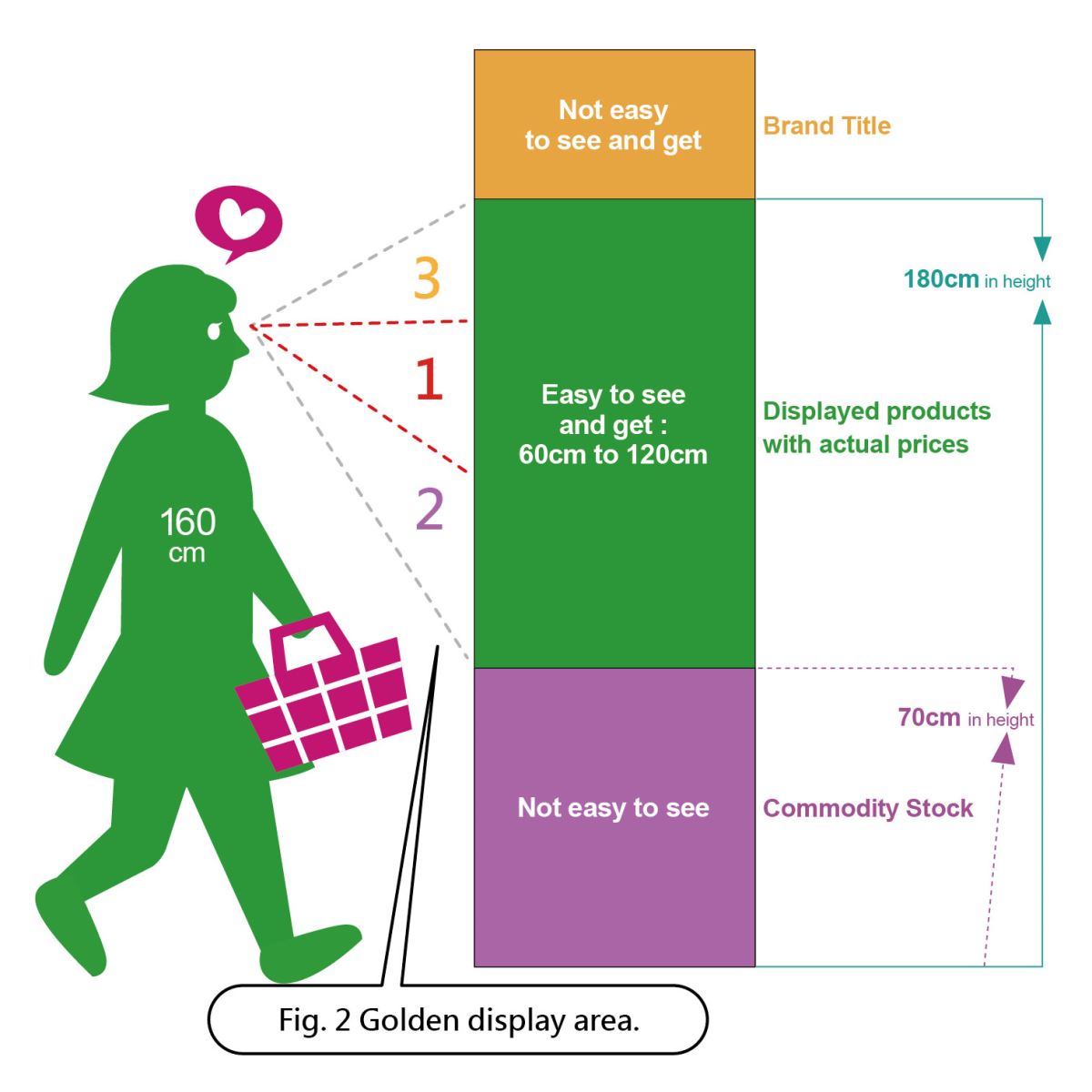
- Easy to get/increasing customers’ desire to purchase
- The “height and depth” within the reach of a customer's outstretched arm should facilitate easy retrieval and return of the commodities. Within the range of human sight, the front of the shelf, being the center and extending to both sides at 70 degrees, is the most visible display area. The height where products are easy to touch is a height below the shoulders. Hence, products displayed on the shelf within 120cm to the left and to the right of the sight are most noticeable and more likely to encourage the consumers to purchase them.
According to research, commodities that are poorly displayed can decrease the customers' desire to purchase.
- Easy to choose/showing freshness and abundance: making products eye-catching
A - Use of shelves for division and stacking (Fig. 3)
Commodities should be classified and placed in areas easy to reach, for example, placing vegetables in groups according to cooking methods or displaying fruits in seasonal classifications. Try stacking fruits and vegetables vertically to make the stall look full and abundant, which is more attractive to the consumers. When stacking, it should be ensured that the fresh fruits and vegetables stacked at the bottom are not crushed or damaged.
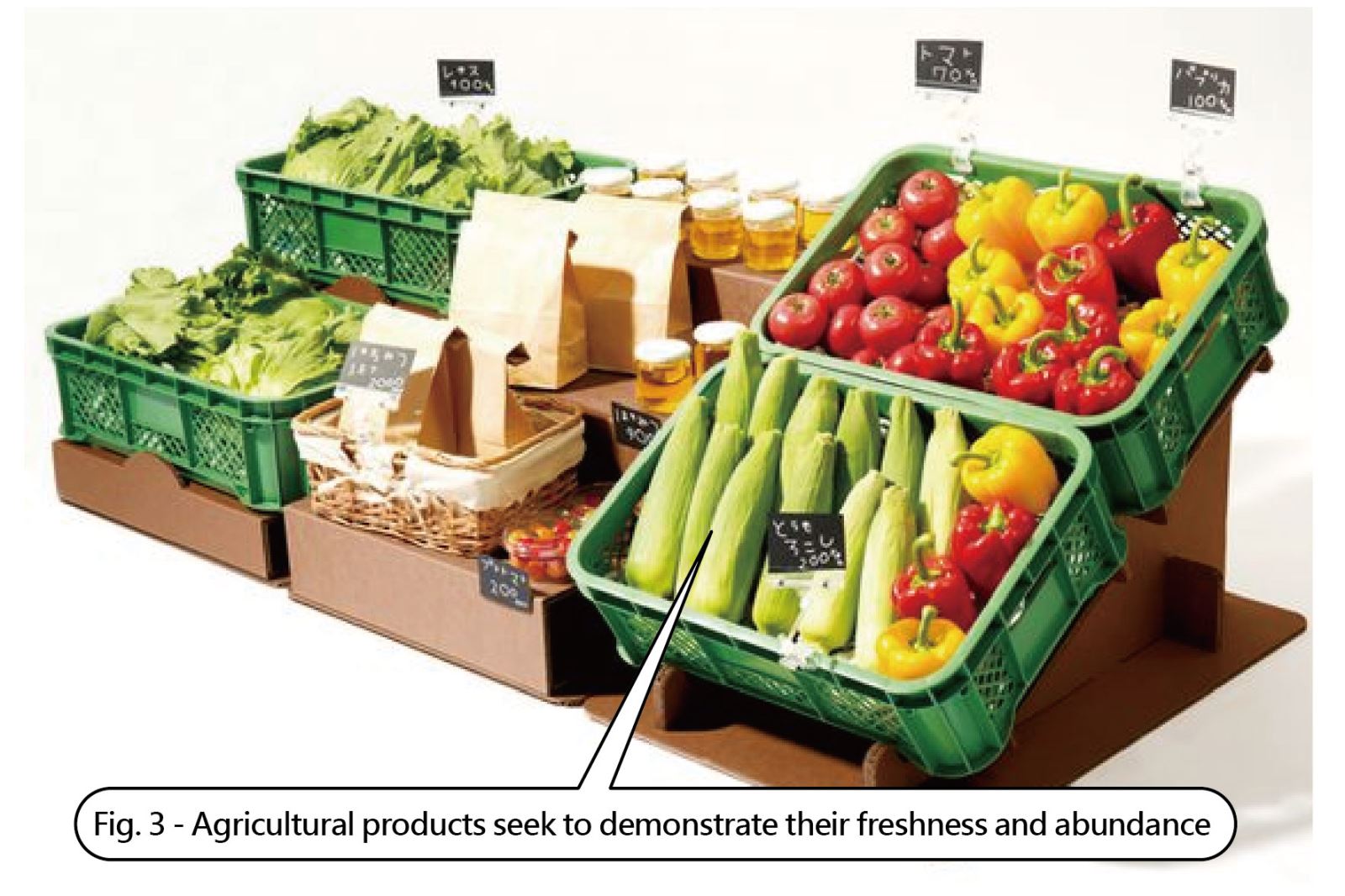
B - Display and size (Fig. 4)
Simulating the flow for shopping and considering how to arrange and display products from the perspective of a consumer directly facing the stall.

- Placing smaller products to the left and larger ones to the right.
- Placing smaller products in the front and larger ones in the back.
- Placing smaller products above and larger ones below.
C - Atmosphere creation for commodities: flexible use of POP (e.g., seasonal products suitable for festivals=pumpkins/Halloween)
- POP product labeling (descriptions of information and prices of agricultural products and labeling of focuses of promotion)
- Positions that are easily seen should be selected for placement. In addition, establishing a brand image facilitates the customers’ memory and helps maintain good relationships with customers.
- Price labels for seasonal promotions should be easy to read and in a combined structure.
- Product descriptions, which can be accompanied by small illustrations, must be concise and informative, delivering messages and showing features to stimulate the consumers’ needs for the commodities.
D - When placing products for display, product introduction signs or price labels should comply with POP. When posting posters, it should be noted that the products and key items for display should not be obstructed or covered.
IV. During Sales/Interaction
- Senses: Using color, aesthetics, freshness, cleanliness, hygiene, sense of quantity, vibrant atmosphere, or the aroma of fruits and vegetables for sensory marketing. For example, “smell” stimulates the consumers’ memory of contact with the products (Fig. 5).
- During interaction, products may be introduced through the combination of stories and marketing.
- The presentation and appeal of commodities should align with the brand personality. Small props may be used to convey the brand image. For example, farmers may attach fruit and vegetable figurines or similar accessories to their clothing, or pick natural lotus leaves and use them as natural table covers, replacing fabric tablecloths. By attracting attention with a relaxed, pleasant and aesthetic atmosphere created with natural materials, new customers can be drawn in.
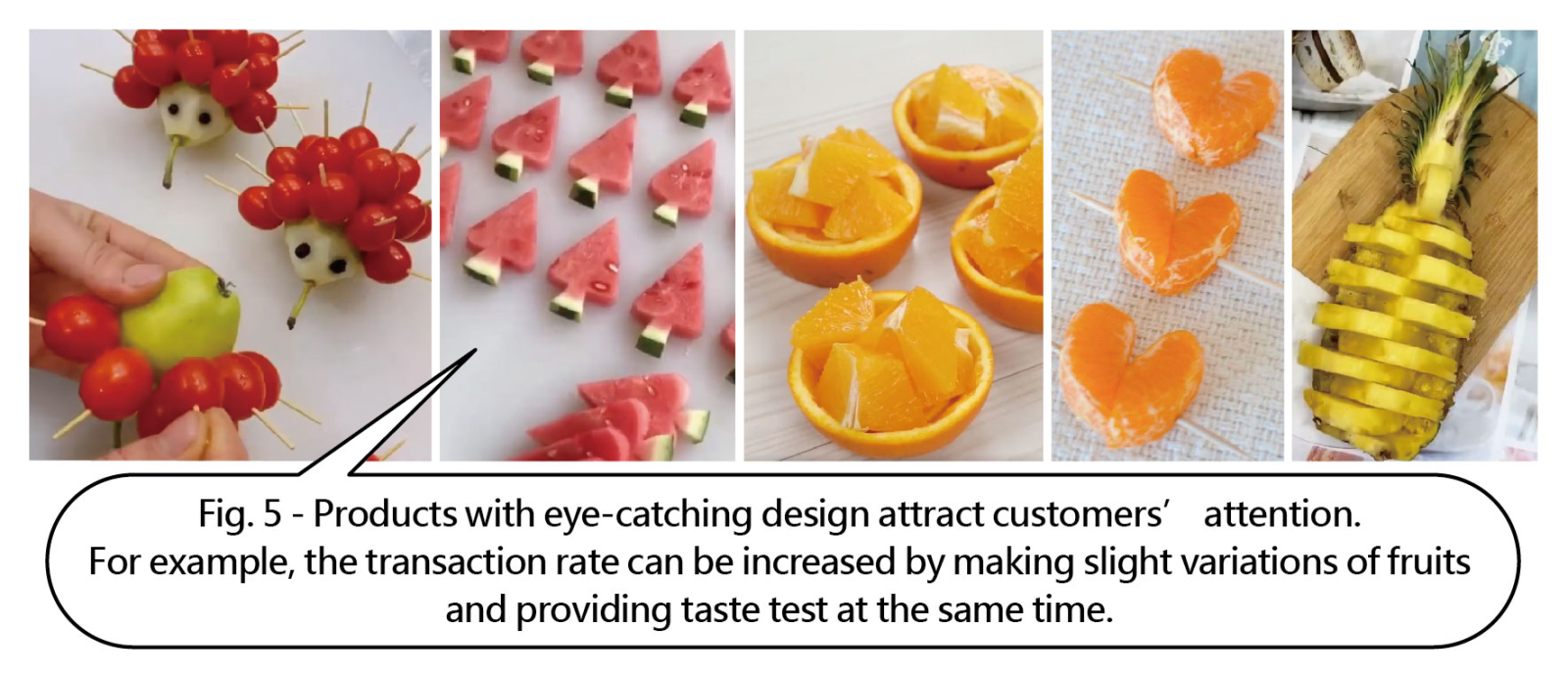
V. After Sales/Cultivation of Repeat Consumption
The packaging of agricultural products shall comply with the brand concept and personality, creating a consistent brand personality and convey it to the consumers. Having a conversation with the consumers, offering samples for tasting, demonstrating cooking methods, and other interactions during the process of sales and marketing is also one of the principles of communicating with customers and introducing the brand. The business hours, QR codes for scanning via cellphones to establish fan communities on Line, Instagram, Facebook, and other social media platforms or delivery of promotion information, regular sharing of quantitative daily information on products along with interactions through the topics of seasonal eating and other relevant adhesive approaches are used to accumulate and increase the customers’ goodwill and build up customer trust in the brand, further stimulating positive reviews that will change into word-of-mouth promotion, so that the customers will become loyal repeat customers. All of the above are necessary for brand accumulation.
VI. Conclusion/Focus on Details
In addition to the above recommendations, appropriate display and placement require further step-by-step management of details for attracting attention continuously. This includes the most suitable placement and flow for shopping, the use of lighting to create an atmosphere for commodities, placement of agricultural products in different directions according to their size, slight adjustment of the tilt of the displayed commodities, and the feel of picking up the products, etc.
By checking details through every practical operation and guiding consumers in participating in seasonal fruit and vegetable exhibitions and sale events, opportunities to introduce “your agricultural commodities” to consumers may be created, thereby creating distinctive displays that allow customers to quickly identify your products at a glance and approach them in the bustling market. This also allows buyers to have relaxed experiences while tasting the “local, seasonal, and agri-food” Taiwanese agricultural products with all five senses as they shop.
Therefore, displays not only show an integrated presentation of “focused sales and aesthetics” but also create a unique brand impression. Through the displays, sales objectives can be achieved and the brand's attraction to consumers can be enhanced. Seize the Point, and capture business opportunities.
.jpg)



